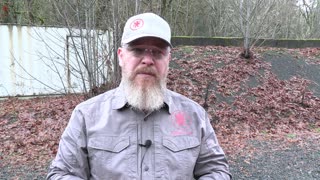Premium Only Content

Spacecraft Makers: Simulating Space to Test Europa Clipper
#europa #spacecraft #spaceship #galaxies #planets #mars #jupiter #moon #nasa #nasamission #europaclipper #earth #spaceexploration #lunarexploration #wolfchamp
Spacecraft Makers: Simulating Space to Test Europa Clipper
How did the team working on NASA’s Europa Clipper spacecraft test whether the spacecraft will work properly in outer space? They put the spacecraft in a special chamber that mimics the kind of sunlight and airless environment the spacecraft will experience when it’s in outer space.
In this video, Tony Licari - a mechanical systems engineer at NASA's Jet Propulsion Laboratory in Southern California - shows how the team moved the main body of the largest spacecraft NASA has ever built for a planetary mission into JPL's historic 85-foot-tall, 25-foot-wide (26-meter-by-8-meter) thermal vacuum chamber. Inside the chamber, the team simulated the kinds of conditions the spacecraft will experience while flying through space, and practiced deploying instruments. Europa Clipper successfully completed those tests in March 2024.
Spacecraft Makers is a video series that takes audiences behind the scenes to learn more about how space missions, like Europa Clipper, come together. Europa Clipper will explore Jupiter’s icy moon Europa to see if there are conditions suitable for life. The spacecraft needs to be hardy enough to survive a 1.6 billion-mile, six-year journey to Jupiter, and sophisticated enough to perform a detailed science investigation of Europa once it arrives at the Jupiter system in 2030.
Europa Clipper is expected to launch in October 2024 from NASA’s Kennedy Space Center in Florida.
For more information on the mission go to: https://europa.nasa.gov/.
Credit: NASA/JPL-Caltech
Spacecraft Makers: Simulating Space to Test Europa Clipper
How did the team working on NASA’s Europa Clipper spacecraft test whether the spacecraft will work properly in outer space? They put the spacecraft in a special chamber that mimics the kind of sunlight and airless environment the spacecraft will experience when it’s in outer space.
In this video, Tony Licari - a mechanical systems engineer at NASA's Jet Propulsion Laboratory in Southern California - shows how the team moved the main body of the largest spacecraft NASA has ever built for a planetary mission into JPL's historic 85-foot-tall, 25-foot-wide (26-meter-by-8-meter) thermal vacuum chamber. Inside the chamber, the team simulated the kinds of conditions the spacecraft will experience while flying through space, and practiced deploying instruments. Europa Clipper successfully completed those tests in March 2024.
Spacecraft Makers is a video series that takes audiences behind the scenes to learn more about how space missions, like Europa Clipper, come together. Europa Clipper will explore Jupiter’s icy moon Europa to see if there are conditions suitable for life. The spacecraft needs to be hardy enough to survive a 1.6 billion-mile, six-year journey to Jupiter, and sophisticated enough to perform a detailed science investigation of Europa once it arrives at the Jupiter system in 2030.
Europa Clipper is expected to launch in October 2024 from NASA’s Kennedy Space Center in Florida.
For more information on the mission go to: https://europa.nasa.gov/.
Credit: NASA/JPL-Caltech
Spacecraft Makers: Simulating Space to Test Europa Clipper
How did the team working on NASA’s Europa Clipper spacecraft test whether the spacecraft will work properly in outer space? They put the spacecraft in a special chamber that mimics the kind of sunlight and airless environment the spacecraft will experience when it’s in outer space.
In this video, Tony Licari - a mechanical systems engineer at NASA's Jet Propulsion Laboratory in Southern California - shows how the team moved the main body of the largest spacecraft NASA has ever built for a planetary mission into JPL's historic 85-foot-tall, 25-foot-wide (26-meter-by-8-meter) thermal vacuum chamber. Inside the chamber, the team simulated the kinds of conditions the spacecraft will experience while flying through space, and practiced deploying instruments. Europa Clipper successfully completed those tests in March 2024.
Spacecraft Makers is a video series that takes audiences behind the scenes to learn more about how space missions, like Europa Clipper, come together. Europa Clipper will explore Jupiter’s icy moon Europa to see if there are conditions suitable for life. The spacecraft needs to be hardy enough to survive a 1.6 billion-mile, six-year journey to Jupiter, and sophisticated enough to perform a detailed science investigation of Europa once it arrives at the Jupiter system in 2030.
Europa Clipper is expected to launch in October 2024 from NASA’s Kennedy Space Center in Florida.
For more information on the mission go to: https://europa.nasa.gov/.
Credit: NASA/JPL-Caltech
Spacecraft Makers: Simulating Space to Test Europa Clipper
How did the team working on NASA’s Europa Clipper spacecraft test whether the spacecraft will work properly in outer space? They put the spacecraft in a special chamber that mimics the kind of sunlight and airless environment the spacecraft will experience when it’s in outer space.
In this video, Tony Licari - a mechanical systems engineer at NASA's Jet Propulsion Laboratory in Southern California - shows how the team moved the main body of the largest spacecraft NASA has ever built for a planetary mission into JPL's historic 85-foot-tall, 25-foot-wide (26-meter-by-8-meter) thermal vacuum chamber. Inside the chamber, the team simulated the kinds of conditions the spacecraft will experience while flying through space, and practiced deploying instruments. Europa Clipper successfully completed those tests in March 2024.
Spacecraft Makers is a video series that takes audiences behind the scenes to learn more about how space missions, like Europa Clipper, come together. Europa Clipper will explore Jupiter’s icy moon Europa to see if there are conditions suitable for life. The spacecraft needs to be hardy enough to survive a 1.6 billion-mile, six-year journey to Jupiter, and sophisticated enough to perform a detailed science investigation of Europa once it arrives at the Jupiter system in 2030.
Europa Clipper is expected to launch in October 2024 from NASA’s Kennedy Space Center in Florida.
For more information on the mission go to: https://europa.nasa.gov/.
Credit: NASA/JPL-Caltech
Spacecraft Makers: Simulating Space to Test Europa Clipper
How did the team working on NASA’s Europa Clipper spacecraft test whether the spacecraft will work properly in outer space? They put the spacecraft in a special chamber that mimics the kind of sunlight and airless environment the spacecraft will experience when it’s in outer space.
In this video, Tony Licari - a mechanical systems engineer at NASA's Jet Propulsion Laboratory in Southern California - shows how the team moved the main body of the largest spacecraft NASA has ever built for a planetary mission into JPL's historic 85-foot-tall, 25-foot-wide (26-meter-by-8-meter) thermal vacuum chamber. Inside the chamber, the team simulated the kinds of conditions the spacecraft will experience while flying through space, and practiced deploying instruments. Europa Clipper successfully completed those tests in March 2024.
Spacecraft Makers is a video series that takes audiences behind the scenes to learn more about how space missions, like Europa Clipper, come together. Europa Clipper will explore Jupiter’s icy moon Europa to see if there are conditions suitable for life. The spacecraft needs to be hardy enough to survive a 1.6 billion-mile, six-year journey to Jupiter, and sophisticated enough to perform a detailed science investigation of Europa once it arrives at the Jupiter system in 2030.
Europa Clipper is expected to launch in October 2024 from NASA’s Kennedy Space Center in Florida.
For more information on the mission go to: https://europa.nasa.gov/.
Credit: NASA/JPL-Caltech
Spacecraft Makers: Simulating Space to Test Europa Clipper
How did the team working on NASA’s Europa Clipper spacecraft test whether the spacecraft will work properly in outer space? They put the spacecraft in a special chamber that mimics the kind of sunlight and airless environment the spacecraft will experience when it’s in outer space.
In this video, Tony Licari - a mechanical systems engineer at NASA's Jet Propulsion Laboratory in Southern California - shows how the team moved the main body of the largest spacecraft NASA has ever built for a planetary mission into JPL's historic 85-foot-tall, 25-foot-wide (26-meter-by-8-meter) thermal vacuum chamber. Inside the chamber, the team simulated the kinds of conditions the spacecraft will experience while flying through space, and practiced deploying instruments. Europa Clipper successfully completed those tests in March 2024.
Spacecraft Makers is a video series that takes audiences behind the scenes to learn more about how space missions, like Europa Clipper, come together. Europa Clipper will explore Jupiter’s icy moon Europa to see if there are conditions suitable for life. The spacecraft needs to be hardy enough to survive a 1.6 billion-mile, six-year journey to Jupiter, and sophisticated enough to perform a detailed science investigation of Europa once it arrives at the Jupiter system in 2030.
Europa Clipper is expected to launch in October 2024 from NASA’s Kennedy Space Center in Florida.
For more information on the mission go to: https://europa.nasa.gov/.
Credit: NASA/JPL-Caltech
Spacecraft Makers: Simulating Space to Test Europa Clipper
How did the team working on NASA’s Europa Clipper spacecraft test whether the spacecraft will work properly in outer space? They put the spacecraft in a special chamber that mimics the kind of sunlight and airless environment the spacecraft will experience when it’s in outer space.
In this video, Tony Licari - a mechanical systems engineer at NASA's Jet Propulsion Laboratory in Southern California - shows how the team moved the main body of the largest spacecraft NASA has ever built for a planetary mission into JPL's historic 85-foot-tall, 25-foot-wide (26-meter-by-8-meter) thermal vacuum chamber. Inside the chamber, the team simulated the kinds of conditions the spacecraft will experience while flying through space, and practiced deploying instruments. Europa Clipper successfully completed those tests in March 2024.
Spacecraft Makers is a video series that takes audiences behind the scenes to learn more about how space missions, like Europa Clipper, come together. Europa Clipper will explore Jupiter’s icy moon Europa to see if there are conditions suitable for life. The spacecraft needs to be hardy enough to survive a 1.6 billion-mile, six-year journey to Jupiter, and sophisticated enough to perform a detailed science investigation of Europa once it arrives at the Jupiter system in 2030.
Europa Clipper is expected to launch in October 2024 from NASA’s Kennedy Space Center in Florida.
For more information on the mission go to: https://europa.nasa.gov/.
Credit: NASA/JPL-Caltech
-
 15:34
15:34
Misha Petrov
14 hours agoReacting To TikTok’s Most DELUSIONAL Takes!
7.42K14 -
 1:52:24
1:52:24
Squaring The Circle, A Randall Carlson Podcast
1 day ago#032 Flournoy Holmes' Artwork Helped Define The Southern Rock Phenomenon of The Early 1970's
15.6K3 -
 19:56
19:56
inspirePlay
1 day ago $0.01 earnedWalking with Lions & Facing Africa’s Wild Side | Safari Adventure with the Grid Championship Crew!
8.97K -
 10:50
10:50
RTT: Guns & Gear
1 day ago $0.72 earnedBudget Friendly Carry 2011: EAA Girsan Brat 2311
10.6K3 -
 3:49:06
3:49:06
Alex Zedra
15 hours agoLIVE! New Game | Nuclear Nightmare
102K13 -
 25:08
25:08
MYLUNCHBREAK CHANNEL PAGE
1 day agoUnder The Necropolis - Pt 2
280K64 -
 1:45:59
1:45:59
Spittin' Chiclets
1 day agoCanadian Chokejob - Game Notes Live From Chicago - 12.28.2024
262K32 -
 9:18
9:18
Space Ice
1 day agoThe Guyver - Alien Bug Suits, Exploding Dragons, & Mark Hamill - Weirdest Movie Ever
167K27 -
 9:31
9:31
Silver Dragons
1 day agoSilver Has Failed - Can it Set the Record Next Year? THIS BANK SAYS YES!
4.94K2 -
 7:08
7:08
GBGunsRumble
18 hours agoGBGuns Range Report 28DEC24
2.94K1